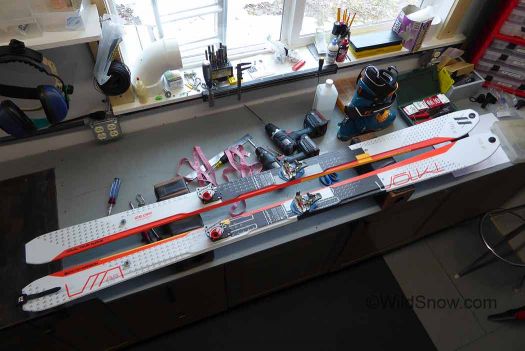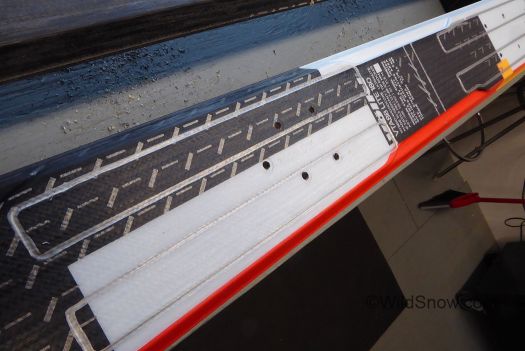“They have to be joking.” That’s the first thought that ran though my mind, about half way through my first turn on Volkl’s latest iteration of their highly engineered Volkl VTA88 LITE touring ski (2016-2017 version). The joke is on me, and it’s on you if you have ever doubted a “one kilo class” touring ski could be made, that, well, skis with dexterity and lubricity beyond a chunk of spring steel.
In fashion typical of what my cultural biases tell me is a good “German” ski, the VTA88 provides substantial torsional rigidity and snap, in combination with modern sidecut, plentiful tip rocker, and no tail rocker. Tilt and carve? They hook up. Get a little chatter in the midst of a higher speed turn? Just rock back a smidge on the supportive tails and embrace your zen. In the pulver, yeah, this is not 100 millimeters but is indeed one of the better “90 mm” planks I’ve been on in the soft stuff.
I know what you’ll ask next: “Lou, when I flex that out in the shop it seems like a carbon squirrely chatterbox, is there any mellow in the equation?” I’m here to tell you that for whatever reason, probably a cosmic cypher secreted in the triple padlocked development department at Volkl, this is not any more a “nervous” ski than a variety of much heavier planks I’ve been on over the years. In fact, perhaps those German engineers chopped up some recycled silk lingerie and mixed it into the core material, that’s how “satin” this lightweight skis. Don’t get me wrong, these are not full-on damped alpine skis, but prepare to be impressed by the weight/performance ratio.
Main point, I had fun skiing these in all but crust conditions where a much wider ski would have been a pool toy for my hesitant technique. If you get on some VTA88s, you’ll have fun too. They go uphill like crazy.
Note the Volkl VTA88 has the interesting Volkl binding mount “H” pattern, only narrowed down enough to accommodate a classic tech binding screw layout (also works with wider layouts such as ION or Dynafit Radical, and of course Marker Kingpin if you feel the need for beef.) I mounted these with a customized Dynafit TLT titanium toe unit and a rebuilt heel I had laying around, for a less than average weight binding setup that pairs nicely with the VTA’s feather mass. An even lighter binding would also make sense. Even a race binding.
This 2016-17 version of the VTA88 appears to have identical geometry to last season’s version. Visual difference is a slight change in graphics. The Ice.Off top sheet can’t hurt, but I didn’t find any remarkable difference in icing between this and a shiny plastic topsheet — though I feel we did notice somewhat of a beneficial effect (every bit helps). Most importantly, I thought these skied better than my testers last season. Problem is my previous pair were a step shorter, and with the VTA88’s plentiful tip rocker you do need adequate length for adequate performance. I liked those diminutive 1,000 gram wonders I skied last year in Norway, but I have to admit these 180s feel much more like a “real” ski on the down.

Heel ok as well. Provided these minimalist mount plates are nicely designed they’re a clever way to save a few grams and help the ski flex. Also not that Volkl sells a pre-cut mohair Coltex climbing skin for the VTA, with a radical trim at tip and tail. Quite lightweight. I’ll cover those more in another blog post.

Proof, at least for the moment, white Volkl topskin with Ice.Off surface works better than a black ski. Different conditions? Who knows?
Length: 180 cm
Weight: 1,133 grams per ski.
Sidecut: 127/88/106 = 39 mm sidecut
Binding offset: <>230 mm (We are beginning to include this, tells you how much ski tail is behind your foot for an idea of how the tails drop in powder and how the tails will do during a kick turn, measurement obtained by setting skis side-by-side and reversing one, then measuring difference between boot mount marks.)
Flex: Medium (in range of “soft, medium, stiff”)
See our review of 2015-2016 version VTA88.
WildSnow.com publisher emeritus and founder Lou (Louis Dawson) has a 50+ years career in climbing, backcountry skiing and ski mountaineering. He was the first person in history to ski down all 54 Colorado 14,000-foot peaks, has authored numerous books about about backcountry skiing, and has skied from the summit of Denali in Alaska, North America’s highest mountain.


